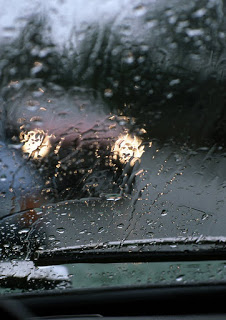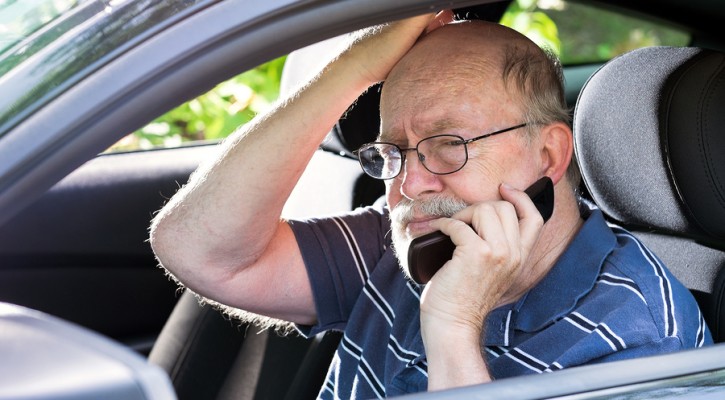Category Archive: Safe Driving

Driver Safety Tips for Spring Storms
May 17, 2010
After the storms last month, I had hoped the age old adage “April showers brings May flowers” would ring true this spring. However, that does need to be the case. Temperatures are dropping and more rain is on its way this way. Although the rain forecast for this week is not supposed to bring storms like the ones New Yorkers experienced last month, it’s still important to review safety techniques for driving in the rain.
First and foremost drivers should remain alert when driving in rain. Rain and wet roadways increase driving risks by lowering driver visibility and making it more difficult to stop quickly. Additionally, drivers must always be on the lookout for debris in the roadways. Debris is especially common when heavy rain is accompanied by high winds. Motorists should always be on the lookout for downed trees and fallen power lines after a windy rain storm.
In addition to remaining alert and keeping an eye out for debris and downed power lines, the following tips will help ensure your safety through any storms this spring and summer bring to your area.
- Don’t speed on wet roads. Drive the speed limit or slower, if need be.Check your windshield wiper blades and tires regularly to ensure your vehicle is equipped to properly handle the effects of inclement spring and summer weather.
- Turn your lights on when driving in the rain. This will make it easier for you to see and for oncoming traffic to see you.
- Be aware of the drivers around you. Treat a non-functioning traffic signal as a 4-way stop sign.
- Don’t attempt to drive through standing water. Many times water appears shallow enough to drive through but standing water can hide dips in the road. So, it’s best to play it safe and turn around and find a different route. Six inches of water will reach the bottom of most passenger cars; this can result in a loss of control or stalling of your vehicle.
- If your visibility becomes heavily impaired it is best to pull over onto a safe spot on the shoulder until the rain eases. Make sure to turn on your flashers once you’ve pulled onto the shoulder. This will make it easier for other drivers to see you.
- Always be aware of the vehicles around you. In addition to impairing driver visibility, high winds can make it difficult for drivers of trucks, SUVs and other large vehicles to control their vehicles.
- During a lightning storm remain in your vehicle. Your vehicle will provide better insulation and protection against a possible lighting strike than being out in the open. However, even while you’re in your car, you avoid contact with any metal surfaces that can conduct electricity.
Rest Areas are Closing
April 21, 2010
The summer is approaching! Are you planning to get into your car or RV and see the sights America has to offer? Will you go north, south, east or west?
It does not seem to matter in which direction you go because many states are having financial problems causing budget deficits and in order to save money, have decided to close rest areas on some of the highways.
It now becomes important to check the states you plan to visit and see if the rest areas are going to be available. You do not want to be surprised if suddenly there is a sign on the road “Rest Area Closed.”
Why are rest areas important? They allow you as a traveler to pull off the roadway, use the restrooms, stretch your legs, walk your dog, if they travel with you, water horses, if that is why you are on the road, eliminate any drowsiness, give your eyes a rest, get a drink, pick up a tourist pamphlet, look at a map and get back on the road. They also are well lit, so it is a safer place to pull off if you need to shut your eyes and nap for a few minutes, especially if you are traveling at night, in rain, or in sun glare.
With less rest areas available there can be more highway crashes because people may just pull over to the side of the road. This can also impact nearby gas stations, convenience stores and restaurants who are concerned about travelers and truckers that have to pull off the roadway and take up parking spaces when they stop only to sleep and use their facilities.
We are always taught to be sure to use well lit areas when stopping. If there is no place to stop it can be dangerous and hazardous for drowsy and distracted drivers to just park along the side of the road.
Although, there has been closing of rest areas in Arizona, Arkansas, California, Louisiana, Maine, Maryland, Michigan, New Jersey, Vermont, Colorado, and South Carolina, Virginia has reopened most of the ones that they had closed , there are other states that might just be cutting back on staff, hours and services. In spite of this, Iowa and Texas are using some stimulus money to replace older rest areas with new ones. Texas is also adding internet kiosks and wi-fi access. The Florida Turnpike is not planning any closures at present, they have 8 service areas that are placed at intervals of approximately 45 minutes apart that provide food, fuel, car repair and towing service to the turnpike customers. They allow drivers to rest on long distance trips to avoid fatigue, this helps to keep this roadway as one of the safest.
If your plans take you to either Alaska or Hawaii, be aware that they have no rest areas at all.
Your mottos for any travel – “Be Prepared” and “Plan Ahead” – seem to be important this year so that you can be safe while on the roads.

Taking The Keys Away From Elderly Drivers
February 18, 2009
More and more adult children each year are facing the heart rending decision of taking the car keys away from elderly parents whose driving behavior has become a danger to themselves and others. This isn’t an easy decision to make because it represents the elderly driver’s sense of independence and dignity. For anyone facing this choice, there are some valuable tools to help you with your decision.
There is no set age at which a driver is no longer able to drive; some drivers maintain their vision, reflexes and physical abilities well into their 80s and 90s while others, due to diseases such as heart disease or diabetes may face the decision of giving up their license in their 50s. The data shows that elderly people, due to their fragility and health issues stand a greater chance of becoming a fatality in a traffic collision but the good news, from an Insurance Institute for Highway (IIHS) study released in December, shows that the death rate for elderly drivers declined steadily between 1997 and 2006 compared to drivers in other age groups. There is no definitive data showing why the death rate for elderly drivers has declined but it is felt that elderly drivers are “self limiting” their driving by no longer driving at night, making shorter trips and avoiding interstates. There is also a feeling that more drivers are surrendering their license on their own when they can no longer pass the vision test or they come to the conclusion on their own that they no longer possess the ability to drive safely.
For those that refuse to surrender their license, the American Association of Retired Persons (AARP) provides the following warning signs:
- Feeling uncomfortable and nervous or fearful while driving
- Dents and scrapes on the car or on fences, mailboxes, garage doors, curbs etc.
- Difficulty staying in the lane of travel
- Getting lost
- Trouble paying attention to signals, road signs and pavement markings
- Slower response to unexpected situations
- Medical conditions or medications that may be affecting the ability to handle the car safely
- Frequent “close calls” (i.e. almost crashing)
- Trouble judging gaps in traffics at intersections and on highway entrance/exit ramps
- Other drivers honking at you and instances when you are angry at other drivers
- Friends or relatives not wanting to drive with you
- Difficulty seeing the sides of the road when looking straight ahead
- Easily distracted or having a hard time concentrating while driving
- Having a hard time turning around to check over your shoulder while backing up or changing lanes
- Frequent traffic tickets or “warnings” by traffic or law enforcement officers in the last year or two
The child, relative or caregiver concerned about the safety of an elderly driver should follow these steps:
- Start a dialogue with the elderly driver expressing your concerns
- Suggest that the driver limit their driving to avoid night driving or long trips.
- Review any medications or medical issues that could diminish the driver’s reflexes and vision or stress causing issues that could affect their driving behavior.
- Travel along with the elderly driver and either videotape or keep notes of missed signs, near misses, confusion etc. Unless you need to intervene to prevent a collision, don’t comment during the drive; it will only make the driver more nervous. Review your findings after the trip.
- Consult with the driver’s doctors to see if any medical issues may limit the driver’s abilities to drive safely.
- Hold an intervention with family members and concerned friends to try to convince the driver to voluntarily stop driving.
The IIHS has information about elderly drivers and a list of state laws concerning elderly drivers at http://www.iihs.org/iihs/topics/t/older-drivers/topicoverview
Drivers in metropolitan areas who are physically unable to drive may be eligible for door to door paratransit transportation. To locate paratransit operators in your area, contact your local county government.
If all else fails and you feel the situation is too dangerous, take the keys and remove the car.

Tips for Driving with Children or Pets in Your Car
January 27, 2009
Anyone who has children knows what a distraction they can be while driving.
Children who are bored, hungry, or fighting with their siblings can turn a pleasant family outing into a stressful situation. A 2006 AAA Foundation study found that 80% of crashes involved driver distraction within 3 seconds of the event. With this in mind, when driving anywhere with children, pre-planning, even on short trips, is critical.
Ensure that children have toys, games, coloring books, and books to keep them occupied. A good idea is to keep children’s travel kits in the car at all times. A mesh bag for each child can be filled with age appropriate travel activities to keep the child occupied.
Some items that can fill the travel kit are:
• Coloring books (use colored pencils instead of crayons that can melt in a hot car)
• Travel versions of popular games such as Battleship, Guess Who, etc. that the children can play with each other.
• Travel sized versions of Etch-A-Sketch for each child.
• Travel sized hand-held electronic games.
• Small personal radios or MP3 players filled with age appropriate music and headphones for each child.
• Age appropriate books.
• Stuffed animals to act as traveling companions.
The back seat may become a bit messy but that is a small price to pay compared to a bored child
An excellent resource full of games, tips, and accessories for traveling with children is MomsMinivan.com. This website also has great information on how to deal with car sickness.
If you can afford it, portable DVD players with the children’s favorite movies are a great way to keep the children occupied. Just remember that DVD screens are not allowed to be in view of the driver. If a DVD player is out of reach, local libraries have audio books that the whole family can enjoy together.
Children (up to 4′ 9″ tall) should always be properly secured in a child safety or booster seat with safety belts. Never allow the children to get out of their seat belts when the car is in motion. Information on the proper use of car seats can be found at the American Academy of Pediatrics website.
Traveling With Pets
Pets, no matter how well trained, can be very unpredictable. Pets should never be allowed to wander around the car or sit in the driver’s lap. Small pets that could jump or fall to the floor where they can interfere with the driver’s operation of the foot pedals can be especially dangerous.
An emergency stop could send a pet plummeting to the floor or into the dashboard where they could be injured. Pets should be secured in a car pet carrier or with a pet harness (available at pet stores) that can be attached to the seat or seat belt.
Rawhide bones can occupy a dog for hours and remember that pets need rest stops too. Make sure you have food and water available on a long trip.
Never leave children or pets unattended in a hot car. Even when it is relatively cool outside, temperatures inside a sealed up car can very rapidly reach dangerous levels on a sunny day.
